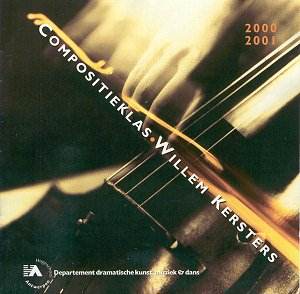Composition Class: Willem Kersters. Thus the
generic title of the present release. Indeed, all the composers featured
in this double-CD set studied, at one time or another, with the late
Willem Kersters at the Royal Flemish Conservatory in Antwerp and most
of them are now teaching at the Antwerp Conservatory.
Willem Kersters was an influential figure of the Flemish
and Belgian musical life. His large and varied output (more than 100
opus numbers) includes five sizeable symphonies (the Fourth is for alto
and orchestra), a number of concertos (his Piano Concerto Op.69
was the test piece for the finals of the 1978 Queen Elizabeth Competition),
a good deal of chamber music (with three substantial string quartets),
orchestral music (including four ballet scores: Parwati Op.10
[1956], Triomf van de Geest Op.17 [1959], Halewyn
Op.62 [1973] and Uilenspiegel de Geus Op.67 [1976]),
choral music and a three-act opera Gansendonk Op.72 completed
in 1982 and first performed in 1984. His Piano Quartet Op.53
was composed for the Quatuor Municipal de Liège of which Henri
Koch was the first violin (as well as the leader of the Orchestre Symphonique
de Liège, as it was then known). It is in three short and concise
movements, of which the central Lento is inscribed to the memory of
Henri Koch who died during the writing of the piece. The basic material
of the Piano Quartet is derived from two main ideas stated
in the very first bars of the piece. The whole work is a good example
of Kersters’ ability to develop musically satisfying structures from
often simple and limited material.
Craens’ November Music is actually a
double concerto for flute, harp and orchestra in two main sections linked
by a short cadenza and capped by an epilogue briefly restating the main
thematic material. The first section is rhythmically free and quietly
unfolds a freely, almost improvised melody whereas the second section
is a lively, dance-like Scherzo. A sizeable, colourful and attractive
work of great charm.
Jace, an Uncalled Answer by Koen Dejonghe
is scored for a small mixed ensemble (8 winds in pairs, harp, 2 pianos,
4 violas, electric guitar, bass guitar and two female voices) that might
compare with instrumental forces often used by Minimalists such as Reich,
Adams or Louis Andriessen. The music, however, is neither minimalist
nor repetitive, even if it may be fairly straightforward and often based
on ostinati. The text sung by the solo voices is "written"
in a totally invented language, which somewhat emphasises the humorous
nature of this delightfully extrovert and entertaining work.
Some time ago, I reviewed a CD with music by Wim Henderickx,
and I then remarked, as other writers did before me, that his music
is often inspired either by some literary stimulus or by non-western
cultures (as in his large-scale Raga cycle). Dawn
for mezzo-soprano, small female chorus and ensemble is a substantial
setting (in English) of three poems by the Lebanese poet Gibran Khalil
(1883 – 1931). Henderickx’s setting of these beautiful and often simple
texts is remarkably subtle and varied, with some very fine moments of
ecstatic rapture enhanced by the ethereal voices of the chorus and the
luminous scoring for small mixed ensemble. At times, the music made
me think of Holst (e.g. the Rig Veda Hymns Op.26 No.3
for female voices and harp or the Bridges Part-Songs Op.44
for female voices and strings), but none the worst for that. Dawn
is a beautifully lyrical and moving work that definitely should
be heard more often.
Vijf Voor Acht Op.9 ("Five for Eight")
by Jan De Maeyer is a suite of five contrasted character pieces for
wind octet. The music has a most refreshing outdoor simplicity and never
outstays its welcome. A very attractive work by all counts and a worthwhile
addition to the rather limited repertoire for wind octet.
A few months ago too, I reviewed a double-CD set devoted
to orchestral works by Luc Van Hove in which the Triptiek Op.29
for oboe and orchestra was also included. This, one of his finest works,
is laid-out into three movements of which the long and emotionally charged
middle movement is framed by two shorter, dreamy and song-like movements.
The present performance is very fine indeed and Robert Groslot conducts
an urgent, dramatic reading of the middle movement to great effect.
A small grumble though: the oboe is a bit too closely recorded so that
distracting noises (clicks) somewhat intrude, but never damagingly so.
Jan Hadermann’s String Quartet of 1973
is one of his earliest acknowledged works. This is a concise, superbly
crafted work in which one senses the young composer flexing his muscles
and, as it were, drawing an interim balance sheet of his musical progress
at the time of writing. An utterly serious, well written and assured
opus and, no doubt, a fine achievement in its own right.
Marc Verhaegen’s Convergences is scored
for nine winds and string quintet. The latter is used en bloc
to offset and compensate for the weight of the wind instruments that
clearly carry most of the musical argument. This superb piece falls
into three neatly contrasting sections, sharing some common thematic
material, which considerably strengthen the global structure of the
work.
All performances are quite good. The young players
of the Antwerp Conservatory Orchestra play with all their heart and
with communicative zest as well as much technical assurance, be it in
the orchestral works or in the ensemble pieces. The recorded sound is
quite good, and production excellent with notes on the composers and
their works, though exclusively in Dutch.
This well-planned and varied selection of substantial
works by distinguished composers offers an interesting, though far from
comprehensive survey of the variety and the vitality of Flemish composers.
This is definitely the sort of enterprise to be wholeheartedly encouraged.
Hubert Culot
AVAILABILITY
Information concerning this double-CD set may be obtained
from:
Koninklijk Vlaams Conservatorium
Desguinlei, 25
B-2018 Antwerpen
E-mail: secr@dptd.ha.be


